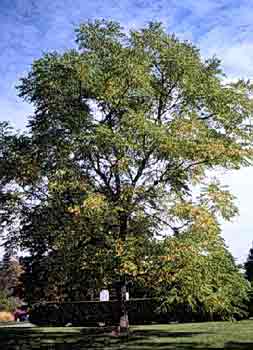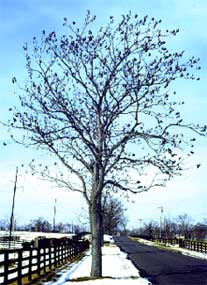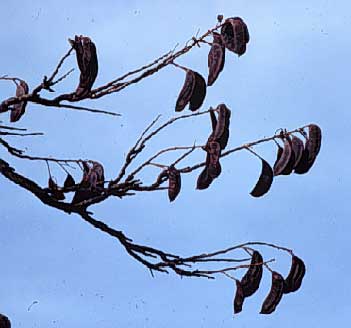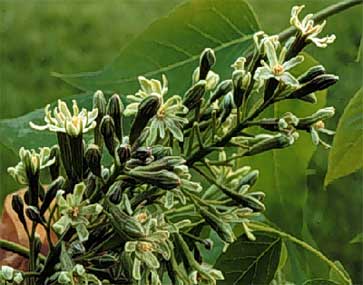 Kentucky Coffeetree - Gymnocladus dioicus
Kentucky Coffeetree - Gymnocladus dioicus
Pea Family (Fabaceae)
At one time the Kentucky coffeetree was the designated state tree. It occurs throughout Kentucky, but is most common in open woods in the Bluegrass. The common name comes from the seeds being used by pioneers as a coffee substitute. The Kentucky champion tree is in West Liberty in Morgan County and is 90 feet tall. It is one of the largest Kentucky coffeetrees in the USA.
- Native habitat: Northeastern and central U.S. Growth habit - This tree has an irregular form with coarse branches.
- Growth habit:
- Tree size: The coffeetree tends to reach a height of 60 to 75 feet with a 40- to 50-foot spread at maturity. It can reach a height of 90 feet. Growth rate is slow to moderate.
- Flower and fruit: Greenish-white, 1-inch flowers are arranged in panicles at branch tips. Panicles are 8 to 12 inches long on female trees; 3 to 4 inches long on male trees. The poisonous fruit is a 5- to 10-inch-long, brown, woody pod that contains sticky pulp and a few large seeds. The toxic alkaloid, cystisine, is neutralized in the roasting process.
 Leaf: Very large (3 feet long and 2 feet wide) compound leaves with numerous leaflets. They are pink-bronze when they emerge in the spring then dark bluish-green in summer. Fall color is yellow but tends to be ineffective.
Leaf: Very large (3 feet long and 2 feet wide) compound leaves with numerous leaflets. They are pink-bronze when they emerge in the spring then dark bluish-green in summer. Fall color is yellow but tends to be ineffective.- Hardiness: Winter hardy to USDA Zone 3b.
There are several cultivars of Kentucky coffeetree that are available in the nursery trade. They include selections that are predominantly male and do not produce fruit. These are preferred as street trees because the large pods can make a mess in early spring when they are shed from the trees in large numbers. Male selections include ‘Espresso.'
Although widely distributed, this tree is a rare forest tree and occurs in scattered populations. The national champion Kentucky coffeetree, 97 feet tall, is in Maryland.
The fruit of Kentucky coffeetree is a typical legume pod,but the flowers are not the typical pea-like form most people associate with legumes. There is some evidence to indicate that the Kentucky coffeetree was introduced into Kentucky by Native Americans, who used pulp from its wood to treat insanity. A tea made from leaves and pulp was used as a laxative. The seeds of Kentucky coffeetree were used by early settlers as a substitute for coffee. However, caution must be taken because the seeds and pods are poisonous. They contain the alkaloid cystisine that can be dangerous. Cystisine is thought to be neutralized in the roasting process. Cattle have died after drinking from pools of water containing fallen seeds and leaves from Kentucky coffeetree.
Gymnocladus dioicus is the botanical name for the Kentucky coffeetree. Gymnos is the Greek word for "naked" and klados is Greek for "branch." This name refers to the large, coarse branches (without smaller twigs) that remain after the rachis and petiole of the bipinnately compound leaves fall. The species name, dioicus, refers to the tree's dioecious nature.
Because leaves of this tree are late to emerge and early to fall, the Kentucky coffeetree is without leaves, or naked, much of the year. Kentucky coffeetree has the largest leaves of our woodland trees. The bark is rough and furrowed and the older branches terminate in a flower cluster, forcing new branches to form in a "zig-zag" pattern. Kentucky coffeetree has reasonably strong wood and will tolerate some ice without losing branches.




